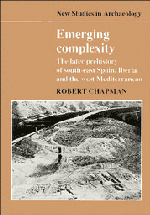Book contents
- Frontmatter
- Contents
- List of figures
- List of tables
- Preface
- 1 Two tribes: questions of theory, scale and explanation
- 2 Hello, goodbye: Iberian prehistory and traditional archaeology
- 3 Another one bites the dust: the implications of the absolute chronology
- 4 Getting better: south-east Spain, the cultural framework 5000–500 bc
- 5 Dancin' in the dark? Adaptation and intensification in south–east Spain
- 6 Centrefield: recent models of intensification and cultural change in south-east Spain
- 7 Into the groove: system scale and technological innovation in south-east Spain
- 8 Out of reach? Complexity, interaction and integration in south-east Spain
- 9 Eliminator: models and the archaeological record in south-east Spain
- 10 Strong persuader: intensification and interaction in Iberia and the west Mediterranean
- 11 With or without you: variability, evaluation and complexity
- Bibliography
- Index
2 - Hello, goodbye: Iberian prehistory and traditional archaeology
Published online by Cambridge University Press: 05 March 2012
- Frontmatter
- Contents
- List of figures
- List of tables
- Preface
- 1 Two tribes: questions of theory, scale and explanation
- 2 Hello, goodbye: Iberian prehistory and traditional archaeology
- 3 Another one bites the dust: the implications of the absolute chronology
- 4 Getting better: south-east Spain, the cultural framework 5000–500 bc
- 5 Dancin' in the dark? Adaptation and intensification in south–east Spain
- 6 Centrefield: recent models of intensification and cultural change in south-east Spain
- 7 Into the groove: system scale and technological innovation in south-east Spain
- 8 Out of reach? Complexity, interaction and integration in south-east Spain
- 9 Eliminator: models and the archaeological record in south-east Spain
- 10 Strong persuader: intensification and interaction in Iberia and the west Mediterranean
- 11 With or without you: variability, evaluation and complexity
- Bibliography
- Index
Summary
The initial reaction against what has been castigated as ‘traditional archaeology’ was best articulated among the Chicago-based students of Lewis Binford in the early 1960s. Since then many archaeologists have contributed to the debate and polemical positions have become commonplace. Binford himself has recently referred to this phenomenon as ‘sociological posturing’ (1983b, p. 108). Given this diversity of positions within theoretical archaeology, it is important to specify precisely what I consider to be the assumptions of traditional archaeology embodied in the interpretation of Iberian prehistory. They may be summarised as follows:
(1) Throughout the prehistoric occupation of the Iberian peninsula the major stimulus for cultural change derived from areas such as the Dordogne (for the Upper Palaeolithic), north Africa (for the Upper Palaeolithic, the Epipalaeolithic and the Early Neolithic) or the eastern Mediterranean (mainly for the Neolithic and Bronze Ages). The assumption for the Holocene period, as for other areas of Europe, was that people were innately uninventive outside a focal area of the Near East.
(2) Within the peninsula this stimulus focused upon a restricted number of ‘nuclear’ areas, from which cultures or cultural traits diffused into other regions.
(3) Cultural assemblages are viewed as static collections of artefact-types whose degree of formal similarity reflects directly their degree of interrelationship. Similarity directly measures interaction. Thus the closer the formal similarities exhibited, whether considered individually or additively, between two or more assemblages, so the closer the social distance between them is thought to be.
[…]
- Type
- Chapter
- Information
- Emerging ComplexityThe Later Prehistory of South-East Spain, Iberia and the West Mediterranean, pp. 18 - 34Publisher: Cambridge University PressPrint publication year: 1990



